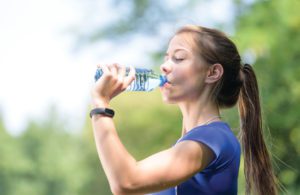 Back to school brings lots of sports practices right in the middle of the hottest part of the day. It’s important for coaches, athletes and parents to be aware of how to prevent heat-related illness. To prevent heat illness (i.e. heat cramps, heat exhaustion, or heat stroke) or even heat stroke deaths during summer sports practices, consider the following important tips:
Back to school brings lots of sports practices right in the middle of the hottest part of the day. It’s important for coaches, athletes and parents to be aware of how to prevent heat-related illness. To prevent heat illness (i.e. heat cramps, heat exhaustion, or heat stroke) or even heat stroke deaths during summer sports practices, consider the following important tips:
1. Know the physical conditioning of the athlete: You should be aware of each athlete’s physical condition prior to the start of practices. While some athletes may be in condition, others may not have exercised at all during the summer. This is an important factor when determining the intensity level of physical activity for athletes, especially in the heat.
2. Acclimate to the heat: Gradually introduce young athletes to the heat to prevent dehydration. Slowly increase the intensity, length of workouts and equipment used over the first 10 to 14 days. This helps train their bodies to drink more, increase blood volume, and sweat more. Sweating helps release heat from the body.
3. Set proper practices times and duration: Practices should be increased gradually to a maximum of three hours long (this is total length of practice, including warm-up and cool down periods), and should be conducted during cooler hours of the day. Avoid practice sessions during the hottest time of the day. Schedule the hardest workouts for early morning or late afternoon/evening.
4. Wear proper clothing: Lightweight, light-colored clothing is best. Ventilated shorts and t-shirts let heat dissipate. For sports that use heavy equipment and pads, let young athletes practice in lighter clothes for a week to acclimate their bodies. Then progress to full equipment.
5. Provide frequent fluid breaks: One of the keys to preventing dehydration, heat exhaustion and heat strokes is to provide players cool down and fluid breaks in a shaded area at least every 20-30 minute, or more frequently, depending on heat and humidity.
6. Know the weather conditions, and plan accordingly: Provide shade and ice water bath. If the field has no shaded areas, put up a tent so players have a place to get out of the sun during their water breaks.
7. Monitor athletes closely: Watch athletes before, during, and after practice for any signs of dehydration or other problems.
8. Rehydrate: After all practices be sure to replace fluids lost.
9. Have an Emergency Action Plan: All staff should be trained on the signs and symptoms of heat illness and what to do during an emergency.
Source: sportsafetyinternational.org








